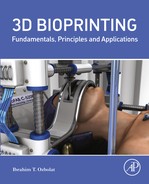Index
‘Note: Page numbers followed by “f” indicate figures, “b” indicate boxes and “t” indicate tables.’
AD-P-8000, 216–222
Affordability, 72
Agarose, 49–57
Amniotic fluidederived stem cells (AFSCs), 50–52
Applications, bioprinting technology
clinics, 286–287
drug screening, 288–293
high-throughput assays, 288–293
limitations, 294–304
bone tissue fabrication, 294–300
cancer research, 304
cardiac tissue fabrication, 300
cartilage tissue fabrication, 300
composite tissue fabrication, 302–303
drug screening and high-throughput assays, 303–304
future directions, 304–305
heart valve fabrication, 300–301
liver tissue fabrication, 301
lung tissue fabrication, 301
nervous tissue fabrication, 301–302
pancreatic tissue fabrication, 302
skin tissue fabrication, 302
tissue engineering and regenerative medicine, 294–303
transplantation and clinics, 303
vascular tissue fabrication, 302
tissue engineering and regenerative medicine, 273–286
cardiac tissue, 276
cartilage tissue, 277–278
heart valve, 278–279
liver tissue, 279–280
lung tissue, 280
neural tissue, 280–281
pancreas tissue, 281
skin tissue, 281–282
types, 285–286
vascular tissue, 283–284
transplantation, 286–287
Autodrop Compact, 216–222
Bioassemblybot, 207–208
Bio3D Explorer, 209
Bio3D SYNˆ, 209
Bio3D technologies, 209
Biofactory, 208–209
Bioink consideration, 147–149
Bioink materials, 43–68
affordability, 72
applications, 75
biomimicry, 72
bioprintability, 71
bioprinting and postbioprinting incubation time, 74
commercial availability, 74–75
compatibility, 71
degradability, 74
immunogenicity, 75
mechanical and structural integrity, 73–74
practicality, 73
resolution, 72
scalability, 73
future directions, 78–81
limitations, 75–77
overview, 42–43
scaffold-based bioink materials. See Scaffold-based bioink materials
scaffold-free bioink materials. See Scaffold-free bioink materials
Biomimicry, 72
Bioprintability, 71
Bioprinter technologies
droplet-based bioprinters (DBB), 217t–221t
Bioassemblybot, 207–208
Bio3D Explorer, 209
Bio3D SYNˆ, 209
Bio3D technologies, 209
Biofactory, 208–209
Fab@Home, 209
Inkredible, 210
Regenovo, 211
functional organ fabrication, 321–323
future directions, 232–233
limitations, 226–232
cartridge and nozzle design, 226–228
compatible bioink materials, 231
cost, 229–230
full automation, 229
limited clinical translation, 232
limited motion capabilities, 228–229
low process resolution, 230–231
research progress, 231–232
size and speed, 228
organs, 329–331
regulatory issues, 332–333
requirements, 201
types, 204–223
Bioreactor, 3–4
Blueprint modeling, 20–26
implicit surfaces design, 25–26
Boundary representation (B-Rep), 22–23
Bovine aortal endothelial cells (bECs), 130–132
Cell transfer process, 174–182
Chemical crosslinking, 47–49
Chinese hamster ovary (CHO) cells, 168–169
Chitosan, 52–53
Commercial availability, 74–75
Compatibility, 71
Constructive solid geometry (CSG), 22–23
Cytoscribing, 42
Cytoscribing technology, 5–7
See also Droplet-based bioprinting (DBB)
Degradability, 74
Design phase
blueprint modeling, 20–26
implicit surfaces design, 25–26
future directions, 34–36
medical imaging, 17–20
computed tomography (CT), 18–19
image segmentation, 20
magnetic resonance imaging (MRI), 18
ultrasound imaging, 18–19
overview, 14–15
steps, 15f
three-dimensional bioprinting, 15–17
toolpath planning, 26–30
Digital imaging and communications in medicine (DICOM), 20
Digital micromirror device (DMD), 169–170
biomaterials used, 147–150
alginate, 147–148
bioink consideration, 147–149
collagen type I, 148
fibrin, 148
methacrylated gelatin, 148
polyethylene glycol, 148–149
substrate consideration, 149–150
bioprinting techniques, 150–151
definition, 126
future directions, 155–156
inkjet bioprinting, 127–134
limitations, 154–155
piezoelectric inkjet bioprinting, 132–134
EBB, See Extrusion-based bioprinting (EBB)
Endothelial cells (ECs), 169–170
Enzymatic crosslinking, 49
Extracellular matrix (ECM) production, 151
bioprinting techniques, 114
defined, 93–95
future directions, 117–118
limitations, 115–116
Fab@Home, 209
Fused-deposition modeling (FDM)-based 3D printers, 22
Gelatin, 54–55
Hardware system, 4
Horseradish peroxidase (HRP), 54–55
Human adipose tissue–derived mesenchymal stem cells (hASCs), 95
Human microvascular endothelial cells (HMVECs), 53–54
Hyaluronic acid, 55–56
Hydrogels
crosslinking mechanisms
Image-based homogenization method, 16
Image segmentation, 20
Immunogenicity, 75
Implicit surfaces, 25–26
Inkjet bioprinting, 127–134
Inkredible, 210
achievements, 187–188
bioprinting modalities, 186–187
classification, 167f
defined, 165–166
future directions, 191–192
modalities, 167–182
cell transfer process. See Cell transfer process
photopolymerization process. See Photopolymerization process
multimaterial bioprinting, 182–186
Laser induced forward transfer (LIFT), 46
LBB, See Laser-based bioprinting (LBB)
Liquid crystal display (LCD), 169–170
MatrigelTM, 56–57
Matrix-assisted pulsed laser evaporation-direct write (MAPLE-DW), 46
Mechanical microextrusion systems, 96
Mechanical/structural integrity, 73–74
Medical imaging, 17–20
computed tomography (CT), 18–19
image segmentation, 20
magnetic resonance imaging (MRI), 18
ultrasound imaging, 18–19
Methacrylated gelatin, 148
Methacrylated gelatin (GelMA), 48–49
Microcarriers, 105–110
Microvalve bioprinters, 139
National Institutes of Health (NIH), 17–18
Natural hydrogels
agarose, 49–57
alginate, 50–52
chitosan, 52–53
collagen type I, 53
fibrin, 53–54
gelatin, 54–55
hyaluronic acid, 55–56
MatrigelTM, 56–57
Nonuniform rational B-spline (NURBS), 25
Optimum porosity, 16
Organ printing
examples, 246f
future directions, 265–266
limitations, 263–265
bioink preparation, 251–252
blueprint modeling, 252–253
cell expansion, 250–251
efficacy, 261–263
immunosurveillance, 261–263
monitoring, 261–263
process planning, 253
remodeling and maturation, 260–261
stem cells isolation/differentiation, 249–250
transplantation, 261–263
vascularized organs, 253–258
in vivo safety, 261–263
state-of-the-art, 245–247
Organ printing stage, 249
Photopolymerization, 48–49
Photopolymerization process
Physical crosslinking, 46–47
Pneumatic-based system, 96
Polycaprolactone (PCL), 247
Poly(ethylene glycol)-diacrylate (PEGDA), 168–169
Poly(ethylene glycol)-dimethacrylate (PEGDMA), 168–169
Polyethylene glycol, 148–149
Polyethylene glycol (PEG), 43–44
Polylactic acid (PLA), 64–65
Porcine vascular smooth muscle cells (PVSMCs), 136
Positron emission tomography (PET), 20
Postbioprinting incubation time, 74
Postorgan printing stage, 249
Practicality, 73
Preorgan printing stage, 248–249
Process parameters, 139
Protein kinase C (PKC) activator, 168–169
Regenovo, 211
Resolution, 72
Scaffold-based bioink materials, 43–65
hydrogels, 43–60
Scaffold-free bioink materials, 65–68
Scalability, 73
Schiff base, 48
Self-assembly, 47
Single, photon emission computed tomography (SPECT), 20
Software system, 4–5
Solenoid microextrusion, 96
Spatial occupancy enumeration (SOE), 22–23
Synthetic hydrogels
Synthetic peptides, 47
Tissue engineering
Toolpath planning, 26–30
Transferring medium, 4
Triply periodic minimum surfaces (TPMSs), 25–26
Two-photon polymerization (2PP), 46
Vascular endothelial growth factor (VEGF), 168–169
Vascularized organs
..................Content has been hidden....................
You can't read the all page of ebook, please click here login for view all page.
